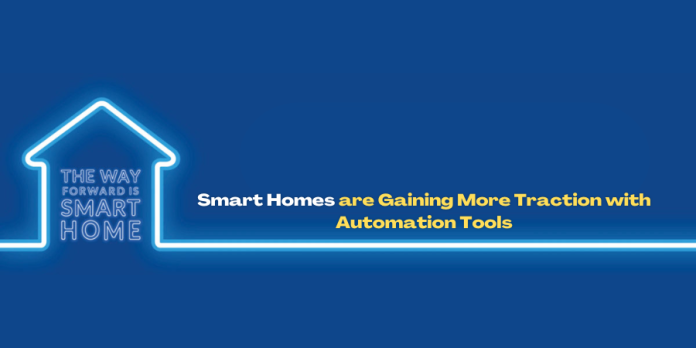Technology is the cornerstone of smart homes, transforming ordinary residences into intelligent living spaces. From smart door locks, garage-door openers, and sensors for lights, audio speakers, curtains, blinds, shades, motion, and air quality, to smart plugs, TVs, security cameras, vacuums, and various appliances—advancements are enabling homes to operate, look, and feel smart. App development software companies are focusing on integrating automated sensing capabilities into apps that seamlessly connect with other smart devices. This growing trend is playing a significant role in the expansion of today’s home construction and renovation markets.
Leading technology companies such as Google, Amazon, Apple HomeKit, Tuya Smart, and Wink are spearheading innovations that empower residents to automate and control their entire homes via smart devices. Beyond personal comfort, the goal of smart homes includes providing affordable access to home utilities. Additionally, the demand for hyper-personalization and sustainable living is being met effectively through these smart technologies. Factors such as increasing internet adoption, the proliferation of mobile devices, and rising awareness of energy efficiency are further propelling the smart home market. The demand is projected to grow as smart devices become more advanced and offer improved interoperability with home appliances.
According to Statista, the global smart home market is expected to expand at a CAGR of approximately 14% from 2023 to 2027, reaching an estimated market value of $210 billion by 2027. In other reports report, the surge in demand for convenient, secure, and safe households is anticipated to drive the smart home sector’s robust growth worldwide.
Key Functions and Applications of Home Automation
- Monitoring air quality for healthier indoor environments
- Remote lighting control for energy efficiency and convenience
- Thermostat control to optimize heating and cooling systems
- Home security systems with live video surveillance
- Automated alarm systems for enhanced safety
- Real-time alerts through text or email notifications
- Voice-activated control enabling hands-free operation
- Keyless entry and smart locks for improved security
- Robotic assistants aiding in household chores and monitoring
Role of Automation Tools in the Rising Demand for Smart Homes
IoT Devices
Smart home devices are interconnected and managed via centralized home automation networks. The integration of Internet of Things (IoT) technology enhances these networks by assigning IP addresses to each device, allowing users to monitor and control them remotely. Equipped with sensors that detect motion, temperature, and light, IoT devices automatically collect environmental data. Cloud-based home automation home automation systems enable remote operation and send real-time status updates and notifications. For example, an IoT sensor connected to a gas line can detect leaks instantly and alert homeowners, greatly improving safety.
Voice Assistants
Voice assistants, once limited to simple tasks such as playing music and retrieving information, have evolved into sophisticated tools capable of controlling entire smart homes. According to Statista, the number of digital voice assistants is projected to exceed 9 billion units globally by 2025. These assistants combine artificial intelligence, natural language processing, and voice recognition technologies to operate home appliances seamlessly. They also integrate with infotainment systems and various gadgets, enabling commands like activating home air conditioning remotely through a car-synced voice assistant.
Smart Robotic Assistants
Smart robotic assistants support daily household tasks such as cleaning, lawn mowing, feeding pets, and monitoring elderly family members. These robots are outfitted with advanced sensors—including thermal, temperature, ground detection, and infrared—enabling versatile functionality. Many also support voice interaction, enhancing user convenience. Unlike other automation devices, robotic assistants feature mounted cameras, allowing them to access hard-to-reach areas of the home, bolstering security by providing comprehensive surveillance beyond traditional cameras’ range.
Mobile Apps
The widespread adoption of mobile devices is a primary driver behind the growth of smart homes. Mobile applications equipped with APIs allow real-time access to multimedia content and live video feeds. Developers are continuously enhancing app frameworks with cutting-edge technologies to create intuitive and reliable smart home apps mobile app developers. These apps enable users to control and automate multiple smart appliances from a single device, offering enhanced flexibility and convenience. With the advent of 5G technology, these applications deliver faster performance and higher-quality video streaming. However, security remains a critical concern, as unauthorized access could compromise home safety. Therefore, developers implement robust security protocols to safeguard against threats like data breaches and software tampering.
Furthermore, emerging smart home ecosystems are increasingly focusing on interoperability standards, allowing diverse devices from different brands to communicate and work together seamlessly. This ecosystem integration not only enhances user experience but also simplifies device management, paving the way for broader adoption of smart home technologies across global markets.
Conclusion
In today’s world where convenience and efficiency are paramount, smart homes offer significant lifestyle enhancements. These homes are not merely symbols of luxury but practical solutions for affordable and energy-efficient living. Advanced technologies such as IoT and AI serve as pivotal enablers, facilitating the full automation and sustainability of residential spaces. Their ability to interconnect and independently control various devices drives the ongoing expansion of the smart home market. Additionally, the evolution of automation tools and the continuous innovation by providers contribute substantially to the increasing popularity and practicality of smart homes.
If you want to explore more about Smart Home Installation Costing, be sure to visit our dedicated Business category for comprehensive insights and updates.

























